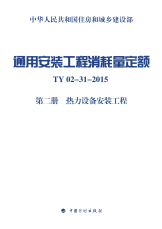
主要责任者: 住房和城乡建设部标准定额研究所
责任方式: 主编
出版者: 中国计划出版社
出版地: 北京
字数: 541 千字
页码: 1-279
开本: 16
中图分类号: TU723.3
分辑名:第二册 热力设备安装工程
语种:中
定价:102.00
出版时间:2015-07
丛书多卷书否:是
书目简介:本册工具书共收录192条词条。
| 词条 | 通用安装工程消耗量定额:ty02-31-2015 |
| 类别 | 中文百科知识 |
| 释义 |  主要责任者: 住房和城乡建设部标准定额研究所 责任方式: 主编 出版者: 中国计划出版社 出版地: 北京 字数: 541 千字 页码: 1-279 开本: 16 中图分类号: TU723.3 分辑名:第二册 热力设备安装工程 语种:中 定价:102.00 出版时间:2015-07 丛书多卷书否:是 书目简介:本册工具书共收录192条词条。 |
| 随便看 |
开放百科全书收录579518条英语、德语、日语等多语种百科知识,基本涵盖了大多数领域的百科知识,是一部内容自由、开放的电子版国际百科全书。